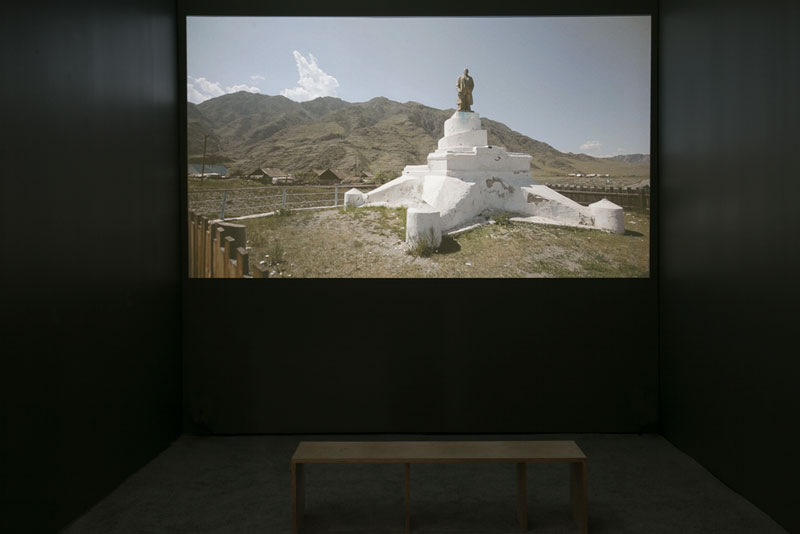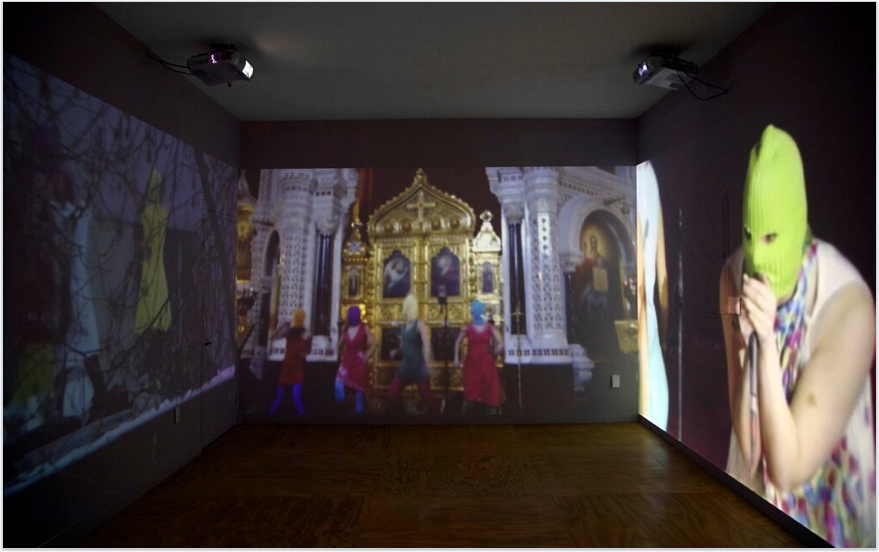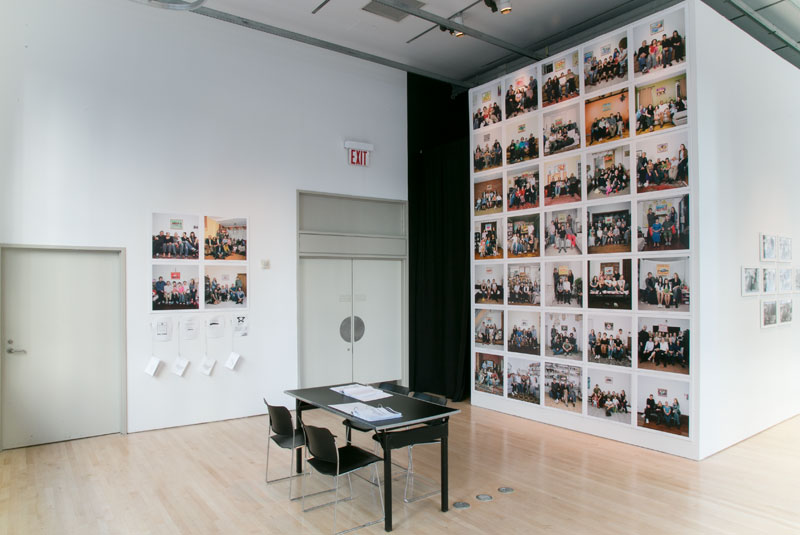Specters of Communism: Contemporary Russian Art, The James Gallery and e-flux, New York
SPECTERS OF COMMUNISM: CONTEMPORARY RUSSIAN ART, THE JAMES GALLERY AND E-FLUX, NEW YORK, FEBRUARY 7-MARCH 28, 2015

In 1961, Nikita Khrushchev famously announced that communism would be achieved in the Soviet Union by 1980. As a result, the nation lived in a perpetual state of the future-perfect tense, aiming for an expected or planned event that was to happen before a certain point in time. Unfortunately, Khrushchev never lived to see that day—nor did anyone else. The realization of true communism was a failure, and because it was abandoned as incomplete, its potentiality still remains, thus making it a tempting subject for artists today.
Specters of Communism: Contemporary Russian Art is not the first exhibition, nor will it be the last to address the afterlives of communism. In fact, it is difficult to stage an exhibition of art from Eastern Europe without mentioning this legacy in the region.(This list of museum and gallery exhibitions is substantial and includes After the Wall: Art and Culture in Post-Communist Europe (Moderna Museet, 1999), Promises of the Past (Centre Pompidou, 2010), and Ostalgia (New Museum, 2011).) Curated by Boris Groys and mounted between The James Gallery, part of the City University of New York’s Graduate Center in Midtown Manhattan, and the gallery at the creative platform e-flux on the Lower East Side, the exhibition featured eight artists who work either in Russia or New York and who deal with this theme. Groys baptizes his selection as “Russian post-conceptual realism,” which he defines as “an attitude” that characterizes “a new generation” of artists who “shift their attention from individual artworks or artistic performances toward their social and political contexts.”(Boris Groys, “Russian Post-Conceptual Realism,” in the exhibition brochure Specters of Communism: Contemporary Russian Art (New York: The James Gallery, 2015): 3-6. This is similar to how Groys defined “Moscow Romantic Conceptualism” in the first issue of the magazine A-YA in 1979.)
Advancing the tradition of realism that was established most notably in France in the nineteenth century, Russian post-conceptualist realists not only depict reality but also intervene—overtly and subtly—within it. Groys aligns these artists with the larger history of conceptual art in and outside Russia through their use of documents, such as photographs and films, which capture their actions. While Specters provided a good representation of this particular trend in recent art from or about Russia, it took effort on the part of the viewer to not only access the works divided between two locations (a significant distance apart from one another), but also to find the time to spend with the works in both galleries. Yet it is through the labor-intensive films, photographs, and documents on display in both galleries that the artists, as well as their audiences, can reflect on and be critical of the social and political conditions in Russia today.
 Criticality is most essential to the work of the St. Petersburg-based collective Chto Delat, which was exhibited in one of the several small black-box theaters constructed at The James Gallery specifically for this exhibition. The group is well known for their staged actions, performances, and films that use avant-garde theatrical devices to produce acerbic commentary on contemporary social and political situations in Russia and across the former Eastern Bloc. This Brechtian revival is a trope of the exhibition Specters, used in other works in the exhibition, such as This is Cosmos (2014) by Anton Vidokle and Love Machines (2013) by Keti Chukhrov, to lesser effects. In the twelve vignettes of Chto Delat’s almost hour-long film The Excluded. In a moment of danger (2014) the actors—all young Russians wearing everyday clothes in a minimalist setting with few props—speak directly to the viewer in an almost confessionary mode, revealing their thoughts, secrets, hopes, and fears. The actors mix concrete events, such as the reelection of Vladimir Putin to a third unprecedented term as President of the Russian Federation in 2012 and the widespread oppression and violence against LGBT persons, with poetic metaphors. One speaks of his tongue as if it has a life of its own, running around the city getting into trouble, not unlike Major Kovalyov’s nose in Nikolai Gogol’s eponymous short story from 1836. Another passionately laments the popularity of Russian rugs, which she wishes would just go away. These somewhat absurd stories told by faces without names create a tension throughout the piece that grips the viewer, who leaves wanting to know more.
Criticality is most essential to the work of the St. Petersburg-based collective Chto Delat, which was exhibited in one of the several small black-box theaters constructed at The James Gallery specifically for this exhibition. The group is well known for their staged actions, performances, and films that use avant-garde theatrical devices to produce acerbic commentary on contemporary social and political situations in Russia and across the former Eastern Bloc. This Brechtian revival is a trope of the exhibition Specters, used in other works in the exhibition, such as This is Cosmos (2014) by Anton Vidokle and Love Machines (2013) by Keti Chukhrov, to lesser effects. In the twelve vignettes of Chto Delat’s almost hour-long film The Excluded. In a moment of danger (2014) the actors—all young Russians wearing everyday clothes in a minimalist setting with few props—speak directly to the viewer in an almost confessionary mode, revealing their thoughts, secrets, hopes, and fears. The actors mix concrete events, such as the reelection of Vladimir Putin to a third unprecedented term as President of the Russian Federation in 2012 and the widespread oppression and violence against LGBT persons, with poetic metaphors. One speaks of his tongue as if it has a life of its own, running around the city getting into trouble, not unlike Major Kovalyov’s nose in Nikolai Gogol’s eponymous short story from 1836. Another passionately laments the popularity of Russian rugs, which she wishes would just go away. These somewhat absurd stories told by faces without names create a tension throughout the piece that grips the viewer, who leaves wanting to know more.
 This sense of something left unresolved permeates the entire exhibition. Even though Groys firmly frames the artists within the Russian context, he states that they also operate on an international platform because they have already “welcome[d] the specters of their own past” by engaging with both the good and the bad of Soviet history.(Ibid.) Undoubtedly, the recent events in and around Russia have veiled this exhibition, namely the work The Inauguration (2012), which is presented in the main room of the gallery at e-flux by the Moscow-based artist Arseny Zhilyaev on behalf of the president-cum-artist Vladimir Putin. This short, silent video follows Putin on the road to the first day of his third term as president. According to Zhilyaev, who has created an in-depth para-fictional artistic practice around the Russian president, the video was ordered by Putin himself and aired live on national television. At e-flux, Zhilyaev presents Putin as an artist consciously and thoughtfully engaged with a variety of modern art movements, including expressionistic painting, such as in the primitively rendered acrylic on canvas Pattern on the Frozen Window (2009), and performance art, such as the document of an antique vase entitled Amphora (2011). Zhilyaev chronicles Putin’s performances throughout the years in his Putin’s Action (2013), a conceptual work comprising an installation of photographs and descriptive texts.
This sense of something left unresolved permeates the entire exhibition. Even though Groys firmly frames the artists within the Russian context, he states that they also operate on an international platform because they have already “welcome[d] the specters of their own past” by engaging with both the good and the bad of Soviet history.(Ibid.) Undoubtedly, the recent events in and around Russia have veiled this exhibition, namely the work The Inauguration (2012), which is presented in the main room of the gallery at e-flux by the Moscow-based artist Arseny Zhilyaev on behalf of the president-cum-artist Vladimir Putin. This short, silent video follows Putin on the road to the first day of his third term as president. According to Zhilyaev, who has created an in-depth para-fictional artistic practice around the Russian president, the video was ordered by Putin himself and aired live on national television. At e-flux, Zhilyaev presents Putin as an artist consciously and thoughtfully engaged with a variety of modern art movements, including expressionistic painting, such as in the primitively rendered acrylic on canvas Pattern on the Frozen Window (2009), and performance art, such as the document of an antique vase entitled Amphora (2011). Zhilyaev chronicles Putin’s performances throughout the years in his Putin’s Action (2013), a conceptual work comprising an installation of photographs and descriptive texts.
 While it may be difficult to take Zhilyaev’s works, which teeter between fact and fiction, seriously, The Inauguration documents a bona fide historical event. On May 7, 2012, just one day after the Bolotnaya Square protests during which hundreds were arrested and injured, Putin’s black Mercedes limousine calmly and smoothly rides through the eerily empty streets of Moscow, passing many of the city’s landmarks. These include the Cathedral of Christ the Savior, where Pussy Riot, whose dissonant sounds can be heard emanating from the adjacent room where four of their clips play on a loop, sang their punk prayer only three months prior from the Bolshoi Moskvoretsky Bridge, where liberal opposition leader Boris Nemtsov was gunned down on February 27, 2015, during the duration of this exhibition. With each passing protest and tragedy, sites in and outside of Moscow gain new meanings and histories that must be incorporated into Russia’s larger cultural narrative.
While it may be difficult to take Zhilyaev’s works, which teeter between fact and fiction, seriously, The Inauguration documents a bona fide historical event. On May 7, 2012, just one day after the Bolotnaya Square protests during which hundreds were arrested and injured, Putin’s black Mercedes limousine calmly and smoothly rides through the eerily empty streets of Moscow, passing many of the city’s landmarks. These include the Cathedral of Christ the Savior, where Pussy Riot, whose dissonant sounds can be heard emanating from the adjacent room where four of their clips play on a loop, sang their punk prayer only three months prior from the Bolshoi Moskvoretsky Bridge, where liberal opposition leader Boris Nemtsov was gunned down on February 27, 2015, during the duration of this exhibition. With each passing protest and tragedy, sites in and outside of Moscow gain new meanings and histories that must be incorporated into Russia’s larger cultural narrative.
Mining a still unfolding history is the task of Anton Ginzburg’s thirty-minute film Walking the Sea (2013), along with his related works Aral Sea Tapestry: Sea-Cotton-Image (2013) and Subnotes (2013), a series of photographic contact silver gelatin prints featuring archival documents from the nineteenth and early twentieth centuries. The subject of these works is the Aral Sea, the salt-water lake between Kazakhstan and Uzbekistan that has been rapidly shrinking due to the effects of poorly planned Soviet irrigation initiatives. As we see in the film, the desert that once surrounded the lake now engulfs it. This project sheds light on one of the darkest sides of an attempt at communism – environmental disaster. In Walking the Sea, Ginzberg wanders across this arid landscape in a beautiful, slow, meditative film that manages to find some color and life in the plants and animals that are able to sustain themselves under the basin’s harsh conditions. Instead of lamenting over the disastrous effects of misguided communism, Ginzberg physically communes with the environment, seeking the potential of this new landscape.

Jeff and Alina Bliumis, a pair of New York-based, Russian-speaking artists born in Moldova and Belarus, respectively, also open themselves up to the potentialities of new landscapes in the work that produced an installation of thirty-nine 24 x 24 inch photographs at The James Gallery. For their long-term project A Painting for a Family Dinner (2008-2013), the Bliumis’ traveled the world from The Bronx to China stopping in Italy and Israel, looking for hosts who would exchange a home-cooked meal for a small sweetly but primitively rendered painting. Their project, which is the only one in the exhibition that does not directly engage with Russia, is documented through photographs where they stand with their temporarily adoptive families and in a set of limited-edition books that trace the project’s steps within each country. Reviving the barter system in the twenty-first century when our transactions have advanced to new currencies, like Bitcoins and devices like Apple Pay, the Bliumis’ humble proposition is inspiring, even though its success is not guaranteed in the capitalist system. A Painting for a Family Dinner allows us to see a positive side of communism because it puts into practice the notion of equal and shared property circulating within an international codependent community.
 Specters attempted to foster this sense of community not only among the artists exhibited but also with the public through a series of programs, including a symposium held at The Graduate Center CUNY on February 9. Kate Fowle, the director of the Garage Museum of Contemporary Art in Moscow, and Arseny Zhilyaev spoke candidly about how communism could be used by artists as material to produce socially and politically effective works within the Russian as well as international contexts. By honing in on the original utopian promises of communism as envisioned in the October Revolution of 1917, Specters positioned the exhibited works as continuing a long-established legacy of radical forward thinking in Russia. This proves useful today as artists—in Russia and beyond—are faced with the dour situation of the contemporary cultural sphere dominated by competing ideological interests.
Specters attempted to foster this sense of community not only among the artists exhibited but also with the public through a series of programs, including a symposium held at The Graduate Center CUNY on February 9. Kate Fowle, the director of the Garage Museum of Contemporary Art in Moscow, and Arseny Zhilyaev spoke candidly about how communism could be used by artists as material to produce socially and politically effective works within the Russian as well as international contexts. By honing in on the original utopian promises of communism as envisioned in the October Revolution of 1917, Specters positioned the exhibited works as continuing a long-established legacy of radical forward thinking in Russia. This proves useful today as artists—in Russia and beyond—are faced with the dour situation of the contemporary cultural sphere dominated by competing ideological interests.



